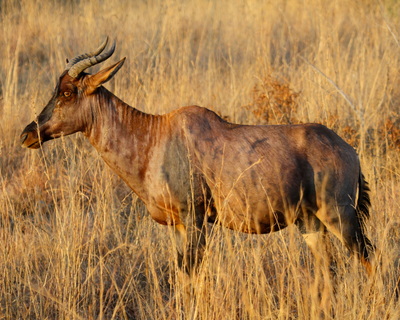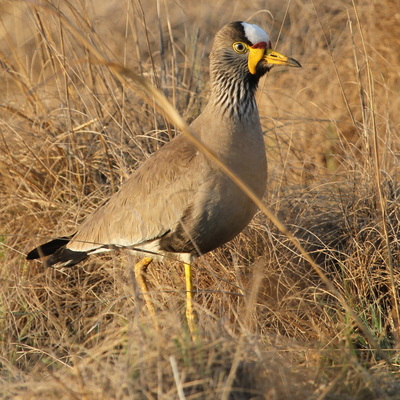|
The staff of the Conservation Ecology group have just returned from another successful field course to South Africa, where Steve and Phil also took the opportunity to catch up with a couple of the group's postgrads (Teegan and Melissa) who are currently stationed out there and working on the impact of burn regimes on biodiversity. Above: Species were taking advantage of the newly burnt areas, even while they were still smouldering, including plenty of Temminck's Courser (left) and an abundance of larks (right - Sabota Lark) and pipits this year. We saw a lot of large mammals whilst working with the fieldcourse students, including four of the 'big five' between us (if we sneak White Rhino in as a replacement for Black Rhino). Pleasingly, we also saw quite a few young White Rhino, which is encouraging given the prolific levels of poaching across South Africa over recent years. Half of the students managed to see two different leopard during one drive - which is a red-letter day by any reckoning! Above: Young male Elephants (left) playing playing in a water hole; a baby White Rhino (centre) that's obviously been rooting in something it shouldn't have been; and daytime grazing Hippos (right). Our camera traps (below) also worked well, picking up lots of nocturnal visitors and interesting activity at water holes and den entrances. Above: A female Ostrich (left) cooling down in the midday heat; an Aardvark (centre) caught on an infra-red nocturnal camera; and a cheeky Slender Mongoose (right) posing for a photo beside a rocky den. We were also inundated with lots of colourful songbirds in the early mornings and cool evenings, though during the hot days they soon retreated to shady thickets, at which times we were reliant on identifying them by their calls and songs. Above: A Crimson-breasted Shrike (left); a Brown-hooded Kingfisher which, unlike most other kingfishers, is happy hunting for insects (rather than fish) in woodland areas; and a Golden-breasted Bunting (right). The student groups spent a lot of time working on the large ungulates, estimating population sizes and carrying capacities, and exploring the impact of burning grassland blocks on utilisation by grazers and browsers. Above: Plain's Zebra (left) were easy to see amongst the grassland areas that haven't been burned for a few years; Klipspringer, a rock-dwelling antelope, were, by contrast, much more elusive to spot amongst bushy rock-slopes where they are extremely agile, moving easily from rock to rock, standing on only the tips of their hooves; Tsessebe (right) are burnt grassland specialists and can usually be found in close proximity to newly burnt areas. Night drives provided views of some of the nocturnal and crepuscular species including opportunist scavengers like Black-backed Jackels and nightjars; the latter are nocturnal avian insectivores related to owls. Owls, by contrast, were very thin on the ground this year. Scorpions were quite common on the camp-site after dark, which made a torch essential when walking at night. Above: Black-backed Jackal (left) were seen quite commonly at dusk and heard frequently at night but this one sat in the open in the middle of the day was an unusual sight; this scorpion (middle) was one of several that were found wandering through the camp at night, before being relocated to a rocky area away from the camp; nightjars, including this Square-tailed Nightjar (I think, I've still to check this properly) (right), were commonly seen resting on the tracks during night-drives, as the tracks retain the warmth of the day longer than adjacent vegetated areas. Thanks to the excellent rains during the last rainy season, the rivers and lakes were still very full of water, leading to a diverse array of wading birds and waterfowl in the area. During the trip we saw at least eight species of herons and egrets, and a similar number of wading bird species, although quite a number of waders in South Africa are principally dry grassland species (see below). There were also plenty of waterfowl and gallinules in and around the dam by our camp. Above: Of the grassland wading birds we saw during the trip, African Wattled Plover (left) and Crowned Lapwing (right) were the most common on short grassland areas; one of the more unusual heron-like species in South Africa is the Hamerkop (centre), which is in a genus and family of its own, due to its unique attributes. The Hamerkop gets it's name from the unusual hammer-headed shape of its head and bill and is a compulsive nest-builder, making several huge nests, which can be 1.5m across and that have a nesting chamber in their centre. Finally, many thanks to the fantastic group of students from Durham (below) who made the field course this year such a success, and also to all of the staff at Mankwe Wildlife Reserve where we stay during the field course.
1 Comment
Michelle Gibson
8/10/2014 06:56:31 am
The rock-dwelling antelope is a Klipspringer (Oreotragus oreotragus)
Reply
Your comment will be posted after it is approved.
Leave a Reply. |
Archives
March 2019
Categories
All
|






















 RSS Feed
RSS Feed
